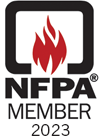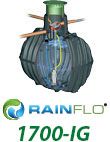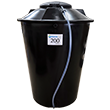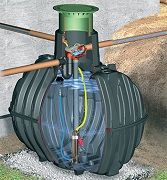-
Brands...
- AquaTel
- Banjo Corp.
- Big Blue
- Bonomi Valves
- Bushman
- Custom Roto Molding
- DAB
- Goulds Pumps
- Graf
- Grundfos
- JED Engineering
- Leader Pumps
- Miscellaneous
- Norwesco
- Poly-Mart
- Polyslab
- Progressive Pump and Treatment
- RainFlo
- RainHarvesting, Pty.
- RainReserve
- Roth Global Plastics
- RTS Companies
- Snyder
- Stenner
- Sterilight
- Tekelek
- UV Pure
- UVMAX
- Viqua
- Accessories...
- Bundles
- Commercial Products
- Complete Systems...
- Controllers...
- Filtration...
- Modular & Stormwater...
- Pumps...
- UV/Ozone...
- Water Tanks - Bolted Steel...
- Water Tanks - Fiberglass
- Water Tanks - Plastic...
- Closeouts
Water Tanks for Fire Protection
 Web: www.RainHarvest.com Tel: 800-654-9283 |
 |

Fire Protection Associations:
The information below provides a basic reference for rainwater collection systems which may be used entirely, or in-part, for fire protection purposes. You should not rely solely on this document for the design or implementation of a water supply system for use in a fire protection or fire suppression system. The best source for official information for your system is your local fire department. Most fire departments will provide you with a written specification or standard if you request one.
The main associations for codes and standards are the National Fire Protection Association (NFPA) and the National Fire Sprinkler Association (NFSA).
NFPA (www.nfpa.org):
NFPA develops, publishes, and disseminates more than 300 consensus codes and standards intended to minimize the possibility and effects of fire and other risks. NFPA membership totals more than 70,000 individuals around the world. NFPA makes its codes and standards available online to the public for free. Most codes and standards for fire protection systems are developed and published by the NFPA.
NFSA (www.nfsa.org)
NFSA is focused on fire sprinkler systems. Their mission statement is "To protect lives and property from fire through widespread acceptance of the fire sprinkler concept".
About NFPA 22:
NFPA 22 is titled the "Standard for Water Tanks for Private Fire Protection"
While strict interpretation of NFPA 22 Section 4.4.1 does not authorize the use of polyethylene (plastic) water tanks or corrugated steel tanks with removable plastic liners, many jurisdictions readily permit the use of plastic tanks because the alternatives are cost prohibitive. One important note regarding corrugated steel tanks with plastic (PVC or EPDM) liners is the concern that the liner could be sucked into the intake and block the flow of water. Precautions such as the use of a Tee connector or similar means to provide an alternate intake should be implemented.
According to the NFPA Technical Advisor board, this standard is specifically written to cover technical details which apply to fire suppression systems which employ fire suppression sprinklers. Water tanks used for drafting (water drawn into a fire truck) do not fall under the scope of NPFA 22. Under some circumstances, NFPA 1142 Annex-B can be referenced for underground cistern applications.
About NFPA 13:
NFPA 13 is titled the "Standard for the Installation of Sprinkler Systems"
NFPA 13D is titled the "Standard for the Installation of Sprinkler Systems in One- and Two-Family Dwellings and Manufactured Homes". According to NFPA, there are no specific criteria for water tanks (materials or structural).
NFPA 13-R is titled the "Standard for the Installation of Sprinkler Systems in Low-Rise Residential Occupancies" and it applies to residential homes up to 4 stories.
NFPA Standards for Above Ground Water Tanks Used for Drafting Purposes:
According to the NFPA Technical Advisory board, there is no standard which applies to the materials or construction of above ground water tanks which are used for drafting purposes (Case# 31873) 5/13/14.
Drafting Connection (FDC) Standards:
The connection to a water tank for residential fire protection is specifically called a drafting connection and is also referred to as a Fire Department Connection or FDC. This is the most important part of the system to get right because the fire department needs to be able to connect to your water source in order to use it. The connection typically consists of a 4” pipe system from the tank with a shutoff (Gate) valve and a suitable connection for the local fire department. You should contact your local fire department to get the specifications for their drafting connection. One typical connection is called National Hose Thread and is abbreviated by NH or NST. Various sizes are available but 4-1/2" NH/NST and 2-1/2" NH/NST are very common. This is a threaded male connector. A matching plastic or brass cap with chain is typically required as well.
Dual-Service Tanks:
A dual-service tank is a tank which is used for both fire protection and is also used for other purposes. The main goal of a dual-use system is to make sure the tank always has an adequate supply to fight a fire, regardless of usage for other purposes. The way this is typically achieved is by using separate plumbing systems for fire protection and for residential use and insuring that the plumbing pipe for residential use does not extend below the water elevation which is necessary for fire protection. The NFPA 22 standard also specifies that separate plumbing systems be used and specifies the same requirement for keeping the plumbing for other purposes above the elevation for fire protection.
Fire Sprinkler Water Quality:
NFPA 13 applies to rainwater collected for fire sprinkler systems. NFPA 13 requires that in the Owner's Certificate (Section 4.3(3)), the owner of the building shall be aware of any special conditions in the water supply that may be responsible for corrosive conditions. This would require an evaluation of the water by Section 24.1.5 of NFPA 13. Water that may have fertilizers or other chemicals could contain an additive (Section 4.4) that can be very corrosive or detrimental to the system.
Below is a list of sections from NFPA 13 that may apply to rainwater if used for sprinkler systems:
• 4.3(3) Owner Certificate
• 4.4 Additives
• 24.1.5 Water Supply Treatment
• 24.1.5.2 Water Supply Evaluation
• 24.1.5.3 Biocides
• 24.2.1 Water Supplies
While a thorough reading of these sections is recommended, it can be summarized as: the water source and quality has to be evaluated prior to implementation and must be consistent. If necessary, NFPA and/or NFSA should be consulted for technical assistance.
For NFPA Members, technical support can be reached at:
• NFPA Technical Advisory: 800-344-3555 Option-3
© RainHarvest Systems 2016












